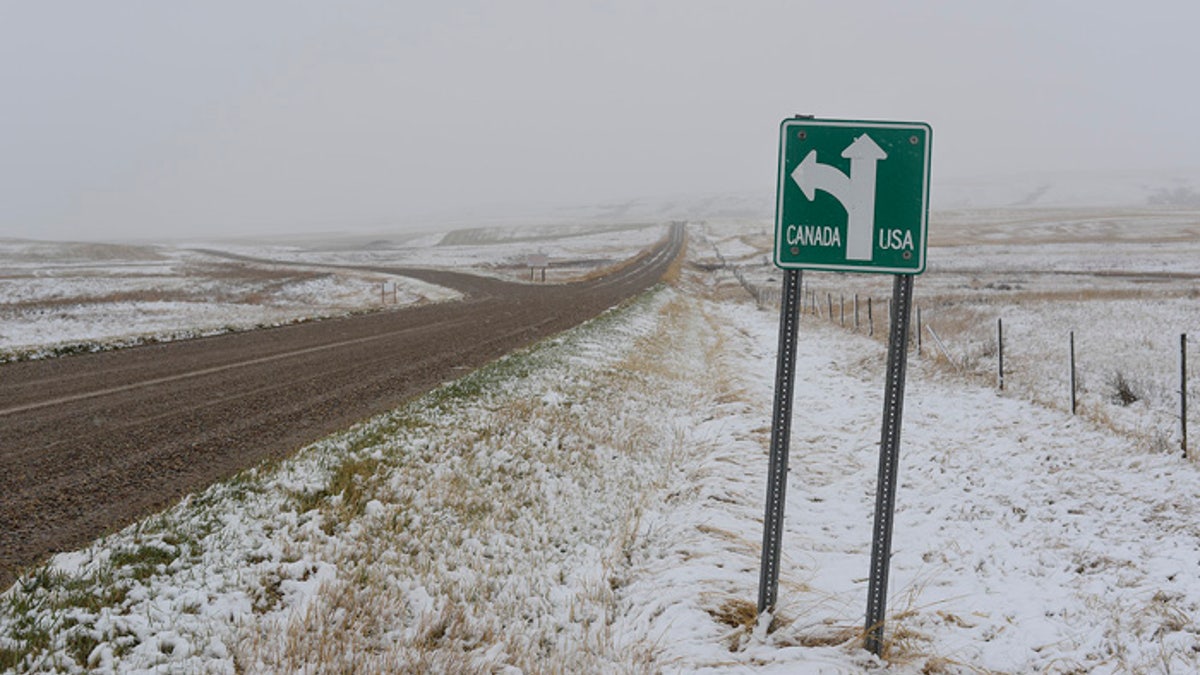
A sign indicates a crossroads along the U.S./Canada border in rural northern Montana. (FoxNews.com) (Gavin John/Crystal Schick)
Lone-wolf terrorists heeding Islamic State’s call to attack inside North America could move easily between the U.S. and Canada, where the enormous border cuts through four Great Lakes and vast areas of remote tundra crisscrossed by back roads seldom seen by either nations’ border patrol agents, experts say.
Last month’s attack on the Canadian capital sparked fresh concerns about the potential cross-border movement of jihadists, an issue former CIA Acting Director Michael Morell raised last month, saying terrorists radicalized in Canada can easily make their way into the U.S. But Canada may have just as much to fear from terrorists coming north from the U.S., and experts say the only practical solution is close cooperation and careful monitoring of threats by both governments.
“To have a secure border, there has to be a partnership with the person on the other side,” said Mike Milne, spokesman for the U.S. Customs and Border Protection. “I can’t emphasize enough that the partnership with the Canadians is really what makes the border work and we have a great team. They go hand in hand.”
Nearly a million people use one of the 300 official border crossings every day, leaving open the possibility of passport fraud and human smuggling. But if terrorists already inside the U.S. or Canada are determined to move undetected between the two nations, there are many undefended passages along the 5,500-mile border. Crossings near the densely-populated areas of Montreal and Toronto to the east and Vancouver in the west are closely guarded, but the vast area in between is not. And to the north, the Alaska border alone covers more than 1,500 miles, much of it unguarded.
[image]
"To stop somebody who has been radicalized in Canada from coming across that border requires that you know about them, that the Canadians know about them and tell us, and that they try to cross that border illegally," Morell said in a CBS interview. "There are many, many ways to cross that border illegally, so I worry about that."
Along the 545-mile border between Montana and Alberta, for example, there are six official, manned ports of entry. But FoxNews.com found dozens more unofficial and undefended crossings. A stretch of road that runs parallel to the border just outside of Sweetgrass, Mont., includes six roads that cross between the countries with nothing but an occasional sign notifying travelers of the border.
Canada has divided the responsibility of protecting the border between the Canadian Border Services Agency at the official ports of entry, and the RCMP in between those points. The RCMP has a specific unit called Integrated Border Enforcement Team that is solely dedicated to protection of the border.
[pullquote]
In the U.S., Customs and Border Patrol under the Department of Homeland Security, is divided into three difference factions, each in charge of a different aspect of border security. The Office of Field Operations coordinates and facilitates entry of goods and people at the official ports of entry, while the U.S. Border Patrol secures the border between the ports of entry. Lastly, the Office of Air and Marine patrols the border from the air and sea.
For the Border Patrol, the main objective is stopping terrorists from coming into the U.S., as evidenced by the agency's own mission statement.
"Since the terrorist attacks of Sept. 11, 2001, the focus of the Border Patrol has changed to detection, apprehension and/or deterrence of terrorists and terrorist weapons," reads the first line of the statement.
The overt call from Islamic State, beckoning its sympathizers to attack inside the U.S. and Canada, both of which are taking part in airstrikes aimed at ISIS in Iraq and Syria, has lawmakers worried about the border.
"There is a great concern that our southern border and our northern border is porous and that they will be coming across," Sen. John McCain, R-Ariz, said in September.
Canadian officials say that under Prime Minister Stephen Harper, who took office in 2006, the nation has increased its own border patrols by more than 25 percent. Canada also has recently undertaken tough new counter-terrorism measures and moved to revoke citizenship from dual nationals shown to have fought with terror groups overseas.
[image]
The number of apprehensions of people illegally crossing in from Canada fell to 3,230 last year, down nearly 1,000 from 2012 and marking at least a 20-year low. By contrast, the Border Patrol apprehended 414,397 people crossing in illegally from Mexico in 2013.
Royal Canadian Mounted Police Cpl. Sharon Franks, Milne’s counterpart north of the border, agreed that cooperation – something often missing between officials on either side of the Mexican border – is key to security.
[image]
“We have a great level of cooperation from the CBP,” Franks said.
Both the RCMP and the U.S. Border Patrol also say they depend on citizens living along the border to report suspicious activity.
“These people are patriots and good citizens and they don’t want to see smugglers or terrorists entering their country," Milne said. "They’re the eyes and ears. It’s very important to coordinate in remote areas where there are limited resources.”
[image]
The RCMP plans to implement new measures along remote parts of the eastern border on the Canadian side, including video cameras, radar, ground sensors, and thermal radiation detectors. Similar measures are already in place in areas around the U.S. Border. But for both sides, much of the responsibility for security lies in the hands of their counterparts across the border.
"We have this unique trusting relationship with the Canadians,” said Milne. “We share a mission, which is the protection of each respective nation.”





















